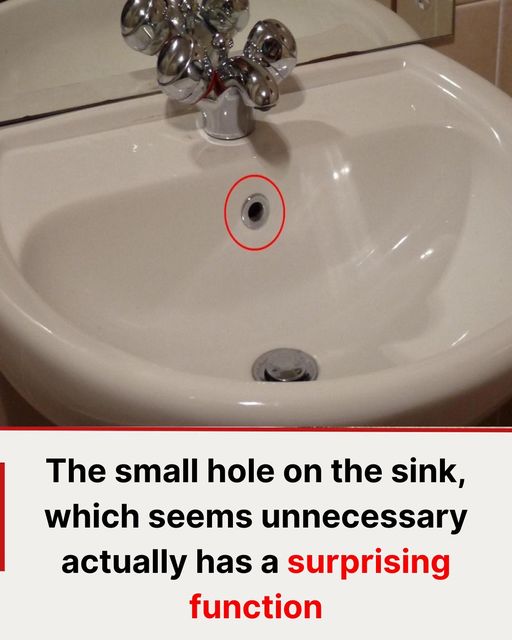Most people have noticed the small hole in their bathroom sink, often located near the faucet, yet not many understand its purpose. It might seem insignificant, but this unassuming hole is a crucial design element that could save you from a flooded bathroom. So, what exactly is it for, and why should you pay more attention to it?
This hole, commonly referred to as the “overflow hole,” is placed strategically to prevent water from spilling over the sink. It sits about one-third of the way up from the basin’s bottom, connected directly to the drainage system. Its role comes into play when, for instance, you leave the faucet running, either by accident or due to distraction. Without this safety feature, the water would eventually overflow, creating a soggy mess on your bathroom floor. Instead, the overflow hole channels excess water safely into the drainage pipe before it can cause damage.
The Overflow Hole in Action
Picture this scenario: You’re in the middle of filling your sink with water, perhaps for cleaning or soaking items, and suddenly the phone rings. In the chaos of the moment, you rush to answer the call, completely forgetting about the running faucet. Water continues to flow into the sink, rising rapidly. In most cases, people would return to find a flooded bathroom. But with the overflow hole, the excess water begins to drain away once it reaches a certain level, keeping your floors safe and dry.
It’s a simple, yet genius design element that highlights thoughtful engineering. Many homeowners and renters remain unaware of its function, even though it plays an essential role in preventing accidental flooding.
A Hidden Cleaning Hazard
While the overflow hole is undoubtedly useful, it does come with its own challenges. One significant issue that many people face is the buildup of bacteria, mold, and mildew inside the hole. Because it’s often in an awkward position and goes unnoticed, this small area can accumulate grime over time. Left unchecked, it can lead to foul odors emanating from your sink, making your bathroom less pleasant.
Bacteria and mold thrive in moist, dark environments, and the overflow hole provides the perfect habitat. Over time, if not regularly cleaned, the growth of harmful microbes can lead to not only bad smells but also potential health concerns.
Simple Cleaning Solutions
Luckily, there are easy ways to maintain cleanliness in this area. A quick DIY cleaning solution can help tackle the issue without the need for harsh chemicals. The best part? You probably already have everything you need in your pantry.
A mixture of vinegar and baking soda is one of the most effective ways to clean the overflow hole. Start by pouring a generous amount of baking soda directly into the hole. Then, follow it with vinegar. The chemical reaction between the two ingredients creates a fizzing effect, which helps to dislodge and break down dirt, grime, and bacteria buildup. Let the mixture sit for about five to ten minutes to ensure it works its magic.
After the waiting period, flush the area with warm water to wash away the loosened debris. This method is not only cost-effective but also eco-friendly, making it a great alternative to store-bought cleaners that may contain harsh chemicals. Plus, it leaves your bathroom smelling fresh and clean.
For deeper cleaning or stubborn buildup, using a small brush or pipe cleaner can help reach those hard-to-access spots inside the overflow hole. Regularly performing this cleaning routine will ensure your bathroom remains odor-free and hygienic.
Preventive Measures
Now that you know the importance of this tiny sink feature, it’s worth considering a few preventive measures to keep it functioning optimally. Cleaning your sink’s overflow hole every few weeks will significantly reduce the risk of bacteria buildup and lingering smells. Additionally, you can use a drain protector to catch any large debris before it gets trapped in the overflow hole, further reducing the likelihood of clogs or slow drainage.
It’s also a good idea to inspect the area occasionally for any signs of wear or damage. In some cases, an older sink may develop cracks or deterioration around the overflow hole, which can lead to leaks or ineffective drainage. Addressing these issues early can save you from costly repairs down the road.
Why It’s More Than Just a Hole
The overflow hole is a small yet vital part of bathroom sink design that goes unnoticed by many. Its ability to prevent potential floods is invaluable, especially in busy households where distractions are common. But more than just a practical feature, it’s a reminder of the thoughtfulness that goes into everyday household designs.
As with many elements of home design, something as simple as a small hole in your sink has a bigger impact than you might think. Without it, the risk of flooding would be far higher, and maintaining a clean, pleasant bathroom environment would be much more difficult.
So, the next time you notice that tiny hole in your sink, take a moment to appreciate its function – and maybe give it a good cleaning!
In conclusion, understanding the purpose of the overflow hole and maintaining its cleanliness can prevent unpleasant odors, bacterial growth, and even serious water damage. Keeping it clean and functional should be a regular part of your household maintenance. Now that you know its importance, take a proactive approach in ensuring your bathroom remains in top condition.
Extra Tips for Sink Maintenance
Aside from the overflow hole, the entire sink area requires regular maintenance to ensure smooth drainage and hygiene. Clean your faucet and the surrounding area frequently to avoid soap scum buildup. If you notice your sink draining slowly, check for clogs in the main drainpipe. Using natural cleaners like vinegar, baking soda, and lemon can help maintain a fresh, clean environment without the need for harsh chemicals.
Incorporating these simple tips into your routine will keep your bathroom looking and smelling great while also extending the life of your fixtures.

